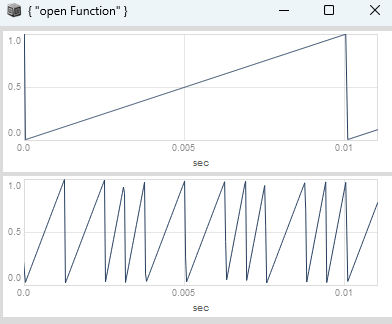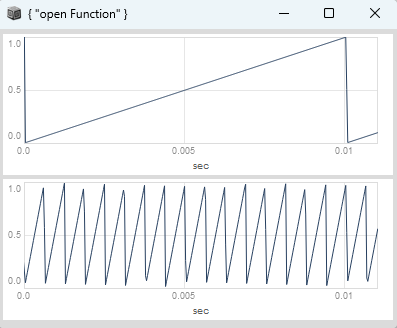Hello,
The Euclidean Rhythm Algorithm by G. Toussaint is an interesting way to create rhythmic patterns, some of which coincide with well known rhythms in various cultures. (https://en.wikipedia.org/wiki/Euclidean_rhythm). Out of the 3 versions of the algorithm known to me, the Bresenham algorithm is the simplest one. Here is an implementation of that algorithm in SuperCollider, in a single statement. I submit this as an example of the expressive power of sclang and a demo of some useful aspects of coding with numerical arrays (instead of explicit iteration).
Cheers,
Iannis Zannos
Attached: (a) Inline code in message, (b) link to jist.
/* Sources:
See: https://codepen.io/Dafuseder/pen/WEqOVw
https://gist.github.com/crashingbooth/e9f0b7dbec8aecabf13db3663d28480f
https://medium.com/code-music-noise/euclidean-rhythms-391d879494df
*/
//:Implementation 1 (plain)
(
~br = { | o = 1, p = 4 |
(o / p * (0..p - 1)).floor.differentiate.asInteger.put(0, 1);
};
// test:
(0..12) do: { | i | postf("bresenham plain. i: %, rhythm: %\n", i, ~br.(i, 8)) };
)
/* // RESULT 1:
bresenham plain. i: 0, rhythm: [ 1, 0, 0, 0, 0, 0, 0, 0 ] // error
bresenham plain. i: 1, rhythm: [ 1, 0, 0, 0, 0, 0, 0, 0 ]
bresenham plain. i: 2, rhythm: [ 1, 0, 0, 0, 1, 0, 0, 0 ]
bresenham plain. i: 3, rhythm: [ 1, 0, 0, 1, 0, 0, 1, 0 ]
bresenham plain. i: 4, rhythm: [ 1, 0, 1, 0, 1, 0, 1, 0 ]
bresenham plain. i: 5, rhythm: [ 1, 0, 1, 0, 1, 1, 0, 1 ]
bresenham plain. i: 6, rhythm: [ 1, 0, 1, 1, 1, 0, 1, 1 ]
bresenham plain. i: 7, rhythm: [ 1, 0, 1, 1, 1, 1, 1, 1 ]
bresenham plain. i: 8, rhythm: [ 1, 1, 1, 1, 1, 1, 1, 1 ]
bresenham plain. i: 9, rhythm: [ 1, 1, 1, 1, 1, 1, 1, 1 ]
bresenham plain. i: 10, rhythm: [ 1, 1, 1, 1, 2, 1, 1, 1 ]
bresenham plain. i: 11, rhythm: [ 1, 1, 1, 2, 1, 1, 2, 1 ]
bresenham plain. i: 12, rhythm: [ 1, 1, 2, 1, 2, 1, 2, 1 ]
*/
//:Implementation 2 (allow o == 0, o > p)
(
~br1 = { | o = 1, p = 4 |
(o / p * (0..p - 1)).floor.differentiate.asInteger.min(1)[0] = if (o <= 0) { 0 } { 1 };
// Note: the if (o <= 0) statement covers the case when we want 0 beats
// in the pattern
};
//
(0..12) do: { | i | postf("bresenham improved. i: %, rhythm: %\n", i, ~br1.(i, 8)) };
)
/* // RESULT 2:
bresenham improved. i: 0, rhythm: [ 0, 0, 0, 0, 0, 0, 0, 0 ]
bresenham improved. i: 1, rhythm: [ 1, 0, 0, 0, 0, 0, 0, 0 ]
bresenham improved. i: 2, rhythm: [ 1, 0, 0, 0, 1, 0, 0, 0 ]
bresenham improved. i: 3, rhythm: [ 1, 0, 0, 1, 0, 0, 1, 0 ]
bresenham improved. i: 4, rhythm: [ 1, 0, 1, 0, 1, 0, 1, 0 ]
bresenham improved. i: 5, rhythm: [ 1, 0, 1, 0, 1, 1, 0, 1 ]
bresenham improved. i: 6, rhythm: [ 1, 0, 1, 1, 1, 0, 1, 1 ]
bresenham improved. i: 7, rhythm: [ 1, 0, 1, 1, 1, 1, 1, 1 ]
bresenham improved. i: 8, rhythm: [ 1, 1, 1, 1, 1, 1, 1, 1 ]
bresenham improved. i: 9, rhythm: [ 1, 1, 1, 1, 1, 1, 1, 1 ]
bresenham improved. i: 10, rhythm: [ 1, 1, 1, 1, 1, 1, 1, 1 ]
bresenham improved. i: 11, rhythm: [ 1, 1, 1, 1, 1, 1, 1, 1 ]
bresenham improved. i: 12, rhythm: [ 1, 1, 1, 1, 1, 1, 1, 1 ]
*/





